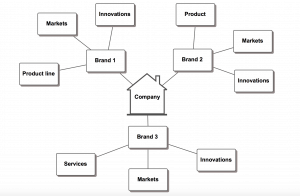
Create Message Maps by topic, not by audience
Imagine you’re driving from coast to coast. How many maps do you need?
You want one map that shows you the whole journey, from end to end. You also may want maps for each place you’ll going to stop for sightseeing or to spend a night.
Just like maps for your cross-country car trip, a set of Message Maps helps you navigate your story easily.
At a minimum, you need an overall Message Map for your company, nonprofit organization and government body. You also may need Message Maps at more granular levels.

That’s why many companies create Message Maps for the company and for each of its:
- Business units
- Brands
- Product lines
- Products or services
- Innovations
- Markets
- Quarterly earnings announcements
- Major events such as trade shows, annual meetings, conferences
- Topics such as sustainability, community relations, charitable activity.
As vice president of communications at Tellabs, I was responsible for dozens of Message Maps about Tellabs, our products, markets, earnings, events and topics. I kept them all together in a binder.

I also shared them with my team, executives and internal clients through a LAN (local area network) folder. The whole team had access to our current messages around the clock and around the globe.
Your Message Maps are an atlas of company messaging
Message Maps enable your whole team to tell your story, respond to media queries, create content marketing, update your website, check facts and turn around communications quicker.
Most important, they help your team to always always always stay on message.
When you co-create a Message Map together with subject-matter experts, executives and the legal department, your Message Map becomes a single source of truth for the company. You get one story, one songbook from which the whole choir can sing.
With a Message Map, you’re always ready to answer a question from news media, an analyst or customer anytime, anywhere in the world. And you can give a consistent answer each time.
There’s a different approach. But frankly, I can’t recommend it
Some companies create separate Message Maps for each audience:
- Customers
- Prospective customers
- Employees
- Prospective employees
- Investors
- Industry analysts
- Regulators
- Sales channels, distributors and agents
- Suppliers
- Communities.

If you take this approach, be extra-careful
No company can afford the consequences and damages that come from talking out of both sides of your mouth.
Watch out for conflicts of interest. You will need to constantly police all the messages to make sure there are no conflicts created among stakeholders.
One example of such a conflict is announcing a price increase. Sometimes companies grow callous about price increases – and it blows up in their face.
Companies can reach a point where no message works, no message is believed. That’s always ugly.
The whole idea of Message Maps is to give you a way to navigate your story, prevent conflicts and head off such problems.
How bad does it get when a message goes wrong?

Turing Pharmaceuticals CEO Martin Shkreli grew notorious for increasing drug prices. He earned headlines like this one in the New York Times: “Martin Shkreli All but Gloated Over Huge Drug Price Increases, Memos Show.”
“Martin Shkreli anticipated huge profits from raising the price of a decades-old drug for an infectious disease, belying any notion that helping patients was foremost in his mind, according to information released by congressional investigators on Tuesday,” the story said.
Called to testify about the price increases before the House Committee on Oversight and Government Reform, Shkreli went silent.
The Times reported:
“Martin Shkreli’s grilling by Congress on Thursday proved to be the spectacle that many had long anticipated.
“Lawmakers excoriated him. He fidgeted, he smirked, he smiled for the cameras. And he refused to answer questions.
“Mr. Shkreli, the former chief executive of Turing Pharmaceuticals, who is facing federal securities fraud charges, repeatedly exercised his Fifth Amendment right to avoid self-incrimination, infuriating members of the House Committee on Oversight and Government Reform.
“’I don’t think I’ve ever seen the committee treated with such contempt,’ Representative John L. Mica, a Florida Republican, said after Mr. Shkreli was excused.”
Shkreli even got kicked off Twitter for the way he communicated with a journalist. Today he’s completely cornered. And silenced.
His problem was that conflicting messages (helping patients, raising prices) boxed him in. He made a series of bad business decisions to raise prices again and again on a drug that people needed. He lost his CEO job, his reputation, even his voice.

Messages that create stakeholder conflicts turn out badly for everyone
Bad messages that lead to conflicts between stakeholders hurt communicators and customers and investors and executives and companies.
If you take the approach of creating a separate Message Map for each audience, be extra-careful. Take responsibility to ensure the absolute consistency across the whole set of Message Maps in your atlas.
Save yourself a lot of work and grief
Take my advice:
Create your Message Maps by company, brand, markets, products and topics. Avoid creating Message Maps by audience, whenever possible.
Related Posts
Creating a strategic message? Think like your audience
Creating a strategic message helps companies deliver a clear, compelling message to the market. My business partner George Stenitzer and I have conducted hundreds...
Top 100 Content Marketing Question: “How do you escalate strategies and goals up to decision-makers?”
A marketer from Kaiser Permanente asked, “How do you best escalate strategies and goals up to decision-makers?” It’s among the Top 100 Questions on...
Top 100 Content Marketing Question: How do we successfully integrate content throughout the marketing department and functions?
Find the right sponsor It takes time, space and resources to successfully integrate content into a marketing department. Since content marketing may take years...
Top 100 Content Marketing Question: How do we target content marketing effectively?
“How to effectively target using content marketing?” Target content marketing effectively by identifying the right audience of buyers – the tribe that craves your...





